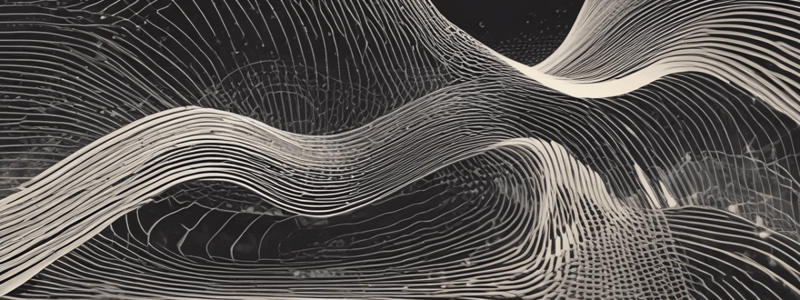Podcast
Questions and Answers
What characteristic of sound is described as loud or weak?
What characteristic of sound is described as loud or weak?
- Intensity (correct)
- Frequency
- Duration
- Timbre
What is necessary for sound to propagate?
What is necessary for sound to propagate?
- Vibrations of air and water
- Vibrations of air only
- Vibrations of the eardrum
- Vibrations of air, water, and materials (correct)
What happens to the sound when it reaches the eardrum?
What happens to the sound when it reaches the eardrum?
- It is decoded and understood
- It is sent through the auditory nerve
- It is transformed into electrical impulses
- It makes the eardrum vibrate (correct)
What is the term for the speed of sound?
What is the term for the speed of sound?
What is the function of the auditory nerve?
What is the function of the auditory nerve?
What happens when we place our hands on the throat and chest when we speak?
What happens when we place our hands on the throat and chest when we speak?
What do we observe when we place salt and pepper on a membrane?
What do we observe when we place salt and pepper on a membrane?
What happens to the candle's flame when a speaker is nearby?
What happens to the candle's flame when a speaker is nearby?
How can we hear our interlocutor speaking from a distance?
How can we hear our interlocutor speaking from a distance?
What happens to the sound when it reaches a solid object?
What happens to the sound when it reaches a solid object?
What is true about low sounds?
What is true about low sounds?
How can we make a sound louder or weaker?
How can we make a sound louder or weaker?
What is true about sound propagation in water?
What is true about sound propagation in water?
Flashcards are hidden until you start studying
Study Notes
Sound and Vibration
- A sound is a vibration that can be felt in our body, as demonstrated by placing hands on the throat and chest when speaking.
- Sound can be observed through the movement of objects, such as salt and pepper grains on a membrane, a candle flame, and a telephone wire.
Propagation of Sound
- Sound vibrations propagate through the air and make other objects vibrate.
- Sound can propagate through water, but not in the same way as in the air.
- The vibration of sound can be blocked or hindered by certain materials, such as plastic.
Characteristics of Sound
- Sound can be low-pitched (grave) or high-pitched (aigu).
- Low sounds have longer and more spread-out waves, while high sounds have shorter and more repeated waves.
- Sound can be loud (fort) or weak (faible), and its intensity can be amplified or attenuated.
- Sound can also be modified in terms of frequency, duration, and timbre (speed).
Sound Production and Perception
- Sound is produced by a source, such as a speaker, and makes the eardrum (tympan) vibrate.
- The vibration is transformed into electrical impulses and sent through the auditory nerve (nerf auditif).
- The sound is then decoded and understood in the brain.
Studying That Suits You
Use AI to generate personalized quizzes and flashcards to suit your learning preferences.




